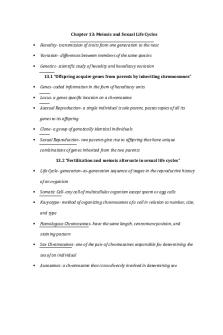Chapter 13 Outline - Summary Campbell Biology PDF

| Title | Chapter 13 Outline - Summary Campbell Biology |
|---|---|
| Course | Introduction to Biology A |
| Institution | University of Pennsylvania |
| Pages | 3 |
| File Size | 55.6 KB |
| File Type | |
| Total Downloads | 69 |
| Total Views | 152 |
Summary
Outline...
Description
Chapter 13: Meiosis and Sexual Life Cycles 13.1 “Offspring acquire genes from parents by inheriting chromosomes”
Parents endow their offspring with coded information in the form of hereditary units called genes
Tens of thousands of genes we inherit from our mothers and fathers constitute our genome
Genes are segments of DNA
In asexual reproduction, a single individual is the sole parent
The genomes of the offspring are virtually exact copies of the parent’s genome
An individual that reproduces asexually gives rise to a clone
Genetic differences occasionally arise due to mutations
In sexual reproduction, two parents give rise to offspring that have unique combinations of genes inherited from the two parents
In contrast to a clone, their offspring vary genetically from their siblings and both parents 13.2 “Fertilization and meiosis alternate in sexual life cycles”
Each somatic cell, any cell other than a gamete, has 46 chromosomes (Diploid 2n=46)
During mitosis, the chromosomes become condensed enough to be visible under a light microscope
Sex chromosomes determine an individual’s sex (X and Y)
Females= XX Males= XY
Gametes contain 23 chromosomes (Haploid n=23)
The human life cycle begins when a haploid sperm cell from the father fuses with a haploid ovum from the mother
Meiosis reduces the number of sets of chromosomes from two to one in the gametes, compensating for the doubling that occurs at fertilization
Plants and some type of algae exhibit a second type of life cycle called alternation of generations
This type of life cycle includes both diploid and haploid multicellular stages
The multicellular diploid stage is called sporophyte
Meiosis in the sporophyte produces haploid cells called spores
A spore divides mitotically to generate a multicellular haploid stage called the gametophyte
A third type of life cycles occurs in most fungi and some protists, including some algae 13.3 “Meiosis reduces the number of chromosome sets from diploid to haploid”
Meiosis has two stages: Meiosis I (separates homologous chromosomes) and Meiosis II (separates sister chromatids)
Theses division result in 4 daughter cells instead of two, each with only half as many chromosomes as the parent cell
Stages of Meiosis I: Prophase I, Metaphase I, Anaphase I, Telophase I and Cytokinesis
Stages of Meiosis II: Prophase II, Metaphase II, Anaphase II, Telophase II and Cytokinesis
Meiosis I is called the reductional division because it halves the number of chromosome sets per cell—a reduction from two sets to one set
The mechanism for separating sister chromatids is virtually identical in meiosis II and mitosis 13.4 “Genetic variation produced in sexual life cycles contributes to evolution”
The events of sexual reproduction that contribute to genetic variation in a population are independent assortment of chromosomes during meiosis, crossing over during meiosis I, and random fertilization of egg cells by sperm
Genetic variation is the raw material for evolution by natural selection
Mutations are the original source of this variation; the production of new combinations of variant genes in sexual reproduction generate additional genetic diversity...
Similar Free PDFs
Popular Institutions
- Tinajero National High School - Annex
- Politeknik Caltex Riau
- Yokohama City University
- SGT University
- University of Al-Qadisiyah
- Divine Word College of Vigan
- Techniek College Rotterdam
- Universidade de Santiago
- Universiti Teknologi MARA Cawangan Johor Kampus Pasir Gudang
- Poltekkes Kemenkes Yogyakarta
- Baguio City National High School
- Colegio san marcos
- preparatoria uno
- Centro de Bachillerato Tecnológico Industrial y de Servicios No. 107
- Dalian Maritime University
- Quang Trung Secondary School
- Colegio Tecnológico en Informática
- Corporación Regional de Educación Superior
- Grupo CEDVA
- Dar Al Uloom University
- Centro de Estudios Preuniversitarios de la Universidad Nacional de Ingeniería
- 上智大学
- Aakash International School, Nuna Majara
- San Felipe Neri Catholic School
- Kang Chiao International School - New Taipei City
- Misamis Occidental National High School
- Institución Educativa Escuela Normal Juan Ladrilleros
- Kolehiyo ng Pantukan
- Batanes State College
- Instituto Continental
- Sekolah Menengah Kejuruan Kesehatan Kaltara (Tarakan)
- Colegio de La Inmaculada Concepcion - Cebu















